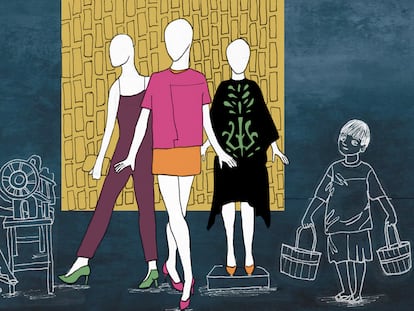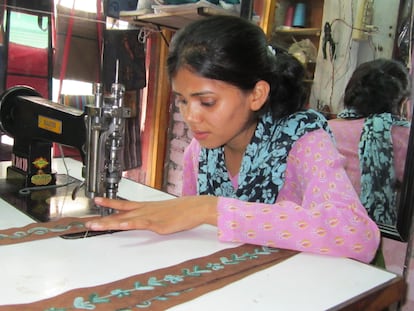Cashmere wars: How the elite fashion commodity is threatening Mongolia’s ecosystem
The huge demand for this wool has wreaked havoc on Mongolia’s soil, put dozens of communities out of work and sparked a battle between large companies for suppliers. Not all cashmere is good quality and not all brands that offer it are honest about the source

For the last few years in Mongolia and northern China, during the spring, huge sandstorms have affected crops and sometimes caused fatalities. The average temperature has risen by about two degrees in the region and rainfall has decreased considerably. The problem now is the desertification of the environment; more than 53% of the soil has been degraded in the last decade because of cashmere, that exclusive wool that until very recently was a preserve of the rich but which is now available for any price, both literally and figuratively.
In 2022, the cashmere market was valued at over $3.5 billion, but by 2030 it is expected to surpass $5 billion. This precious wool comes from the cashmere goat, which lives in extreme weather conditions and consequently develops a layer of wool inside its outer coat to protect it from the cold. “It is from this wool that the fibers are obtained, and the length and fineness of the fibers are crucial factors,” says Lola Sagarra Tejada, brand manager at Stone, an artisanal cashmere brand that has just signed a collaboration with the Spanish brand Mint & Rose. “The longer and finer the fibers, the softer, more durable and more resistant the fabric will be.”
According to Sagarra, the way cashmere is processed and woven also affects its quality. “Good cashmere is produced using techniques that preserve the softness and integrity of the fibers. The use of traditional, artisanal techniques rather than industrial methods is often associated with high-quality cashmere products. Manufacturers who pay attention to every detail in the manufacturing process contribute to the creation of garments that are not only soft, but also durable and resistant,” she says. If this raw material has been ‘democratized’ recently, it is precisely because the length, fineness and techniques for processing the yarn are not the same as they once were. It is also due to the proliferation of garments that are not 100% cashmere. “With some products, cashmere accounts for only 5% and is mixed with polyester, but even so, the law states that it can be labeled as ‘cashmere blend,’” according to a report on the Business of Fashion website on why you can now buy cashmere sweaters at a reasonable price.
But growing demand has meant that in Mongolia alone, there are now 27 million cashmere goats, almost eight for every inhabitant. There is not enough land to raise and feed them in a dignified manner and the soil has already degraded. In 2018, the United Nations development program was forced to launch a platform for sustainable cashmere in Mongolia, a kind of action plan for controlling its production but which is still in the process of being implemented. For it is not only the health of the environment that is at stake, but also the survival of its inhabitants.
More than 10% of Mongolia’s population is nomadic, consisting of around 300,000 herders who live by raising cashmere goats. “Cashmere production is rooted in their culture, which has existed for centuries,” says Sagarra. “By supporting this way of life, cashmere contributes to preserving traditions and cultural practices of local communities. The sale of cashmere is the main income for many of these families,” she says, adding that the Chinese cashmere industry “is gradually monopolizing its production and distorting the value chain.”
The truth is that there has long been a cashmere monopoly. Erdos, a company headed by Chinese businesswoman and so-called cashmere princess Jane Wang, is perhaps the world’s largest cashmere exporter. It used to supply all the luxury brands until almost a decade ago when it decided to focus on its own brand, called 14-36, in reference to the fineness and length of the wool. It now has more than 300 stores in Asia. In Mongolia, Gobi is the big player, becoming one of the country’s main suppliers in 1981 when it set up a large factory for processing raw materials.
Four decades later, Gobi has also become one of the main guarantors of the survival of nomadic communities, ensuring the production process is transparent to the consumer. “Nomadic communities do not mistreat the goats with harmful practices because they work with traditional processes, such as hand-combing the wool,” according to a spokesperson for the brand.
If there is a brand we associate with cashmere, it is Loro Piana, which epitomizes what is known as quiet luxury — a trend that has pushed up demand for this raw material and whose garments sometimes carry a four-figure price tag. In 2013, the family-owned firm was bought by the world’s largest luxury goods company, LVMH, which, in 2018, became the first to detail, via QR codes, the source of each cashmere garment in their inventory.
The volume of quality cashmere LVMH needed was being threatened by Chinese monopolization and the increasingly scarce traditional resources to meet demand. But the financial muscle of Bernard Arnault’s holding company enabled them to find new suppliers to guarantee the exclusive quality of the product. It is also no coincidence that the traditional centers of artisanal spinning of Mongolian cashmere, mostly in Scotland and Italy, are disappearing in favor of textile workshops in Southeast Asia where basically anything can be produced. So, it is no coincidence either that Chanel has bought the Scottish firm Barrier and has allied with the other icon of quiet luxury, Brunello Cuccinelli, to take over Cariaggi Lanificio, one of the traditional cashmere manufacturers.
While a third of Mongolia’s population sees its way of life endangered and the country faces the desertification of its environment, the consumer is shaped by misinformation favored by companies’ interest in selling luxury products at an affordable price. Cashmere created under unfair conditions, for goats and workers, is still soft, but it is not durable because it does not follow the traditional maintenance protocol. “Most people don’t know what real cashmere is or are unaware of the range of quality in the market, because some brands may use blends or lower quality fibers and label them as cashmere,” explains Pere Autonell, co-founder and commercial director of Spain-based family business Mirror in the Sky, which works in certain areas of Nepal with suppliers and breeders. “Information is what leads to the appreciation of authenticity and quality in this industry.” Mirror in the Sky employs women from rural communities, teaching them traditional techniques, both in cashmere goat breeding and spinning.
It is surprising to realize that a raw material can be both a source of development and, at the same time, destroy the ecosystem of a country. This is the paradox of fashion, which has managed to make the unique into something homogeneous and affordable. But in a scenario made up of destructive mass production and large holdings monopolies — if at the start of the century LVMH and Kering were the protagonists of the luxury handbag war, they could now well be the protagonists of the cashmere war — there is an alternative; there is recycled cashmere, provided that it is durable and not mixed with other raw materials, as is the case with cheap cashmere. Recycled cashmere is used by brands such as Reformation, Patagonia and Ralph Lauren, but it is obviously more expensive than the cashmere sold for double digits. Above all, there are other options that are just as soft and durable, such as camel or yak hair, an alternative advocated by both activists and scientists. But, once again, the average consumer does not know this, because at the moment it is “not in the market’s interest.”
Sign up for our weekly newsletter to get more English-language news coverage from EL PAÍS USA Edition
Tu suscripción se está usando en otro dispositivo
¿Quieres añadir otro usuario a tu suscripción?
Si continúas leyendo en este dispositivo, no se podrá leer en el otro.
FlechaTu suscripción se está usando en otro dispositivo y solo puedes acceder a EL PAÍS desde un dispositivo a la vez.
Si quieres compartir tu cuenta, cambia tu suscripción a la modalidad Premium, así podrás añadir otro usuario. Cada uno accederá con su propia cuenta de email, lo que os permitirá personalizar vuestra experiencia en EL PAÍS.
¿Tienes una suscripción de empresa? Accede aquí para contratar más cuentas.
En el caso de no saber quién está usando tu cuenta, te recomendamos cambiar tu contraseña aquí.
Si decides continuar compartiendo tu cuenta, este mensaje se mostrará en tu dispositivo y en el de la otra persona que está usando tu cuenta de forma indefinida, afectando a tu experiencia de lectura. Puedes consultar aquí los términos y condiciones de la suscripción digital.
More information
Archived In
Últimas noticias
There is as much life left to discover on planet Earth as that which is already known
Dozens presumed dead, around 100 injured in fire at Swiss Alps bar during New Year’s celebration
Is porn for women different from conventional porn? We spoke to those who make it
Cartagena de Indias is sinking: What can the city do to mitigate it?
Most viewed
- Sinaloa Cartel war is taking its toll on Los Chapitos
- Reinhard Genzel, Nobel laureate in physics: ‘One-minute videos will never give you the truth’
- Oona Chaplin: ‘I told James Cameron that I was living in a treehouse and starting a permaculture project with a friend’
- David King, chemist: ‘There are scientists studying how to cool the planet; nobody should stop these experiments from happening’
- Why the price of coffee has skyrocketed: from Brazilian plantations to specialty coffee houses











































